

Male Triturus cristatus. Photo by R. Griffiths.
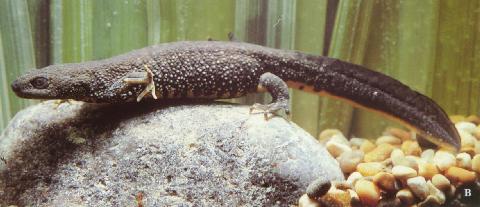
Female Triturus cristatus. Photo by R. Griffiths.
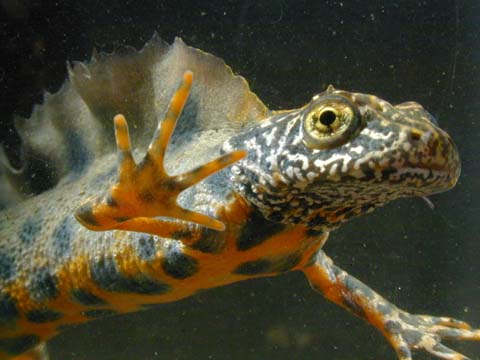
Male Triturus carnifex.
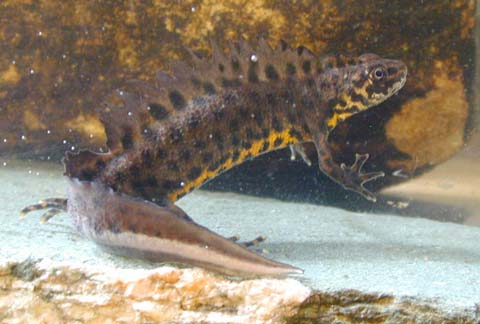
Male Triturus karelinii.
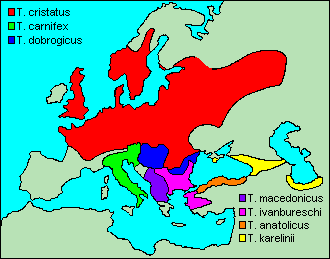
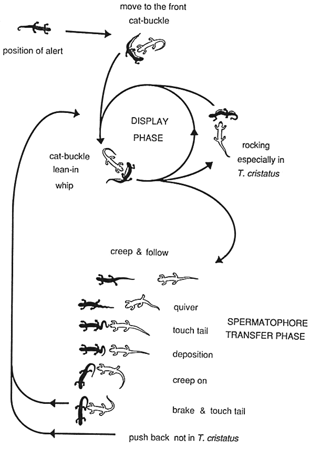
Mating behaviour of all species: male shown in black, female in white. From Arntzen & Sparreboom (1989).
DESCRIPTION
The crested newts are the largest (to 18cm) and most heavily built newts of the genus Triturus. They have a warty skin, quite unlike the smooth or granular skin of the smaller species. The back is dark brown or black, and there may be white stippling along the flanks. The belly is usually yellow or orange, with large black blotches or spots. The males develop a high, toothed, black crest during the breeding season, and a white band along each side of the tail.
SPECIES
The group was originally considered as a single species, T. cristatus, but this is now considered a 'superspecies' consisting of up to seven distinct species.
Triturus anatolicus: The Anatolian Crested Newt
The crested newts of Northern Turkey have recently (Wielstra & Arntzen, 2016)
been described as a new species, previously being included in T. karelinii.
They are currently distinguishable from T. karelinii only by molecular genetics.
As with T. karelinii, the belly colouration usually extends onto the throat.
Triturus carnifex: The Italian Crested
Newt
The Italian crested newt has a distribution centred around Italy
and the former Yugoslavia. Females and juveniles may exhibit a
yellow dorsal stripe, which is usually absent in the other
species, and there is little white stippling on the flanks. The
throat is yellow and black with white stippling. .
Triturus cristatus: The Northern Crested
Newt
The northern crested newt is widely distributed across northern
Europe. The wide distribution of this species leads to some
variation in appearance, though white stippling is almost always
present on the flanks, and the throat is dark with similar
stippling.
Triturus dobrogicus: The Danube Crested
Newt
Formerly also known as T. cristatus danubialis, the Danube
crested newt has a restricted distribution around the Danube
flood plains. This species is the smallest and least bulkily
built of the cristatus group. Males have a particularly
high crest, which may extend onto the head.
The distribution of this species is not well known. It has a
small range, and, apart from a small part of the Black Sea coast,
its distribution is bordered by the ranges of other crested newt
species. This leads to hybrid zones where the ranges meet, making
it difficult to establish the exact distribution of the pure
species (Arntzen et al, 1997). Two subspecies are currently
recognised: T. d. macrosoma (also known as T. d. macrosomus)
occurs in the western part of the range (above the 'Iron Gate' of
the Danube), with T. d. dobrogicus occuring to the east.
Triturus ivanbureschi: The Balkan Crested Newt
The crested newts from the Eastern Balkans and north-west Turkey have recently
(Wielstra et al., 2013) been described as a species in their own right,
distinguishable from T. karelinii only by molecular genetics.
The previously (Themudo et al., 2009) proposed T. arntzeni
(covering the Eastern Balkans and western Turkey)
has been discarded due to misidentification of the type specimen.
As with T. karelinii, the belly colouration usually extends onto the throat.
Triturus karelinii: The Southern Crested Newt
The southern crested newt occurs in the Caucasus and north-eastern Turkey.
Belly colouration usually extends onto the throat.
Until recently, all crested newts from the Eastern Balkans,
Turkey and the Caucasus were assigned to T. karelinii.
They are currently regarded as three species; T. ivanbureschi in the west of this range,
T. anatolicus in the centre, and T. karelinii in the east.
Triturus macedonicus
The crested newts found in the West of the Balkans have recently
(Arntzen et al, 2007) been described as a species in their own right,
previously being regarded as a subspecies of T. carnifex.
These species are all very closely related, and hybrids have been succesfully bred from most combinations. This group of species, together with the marbled newt, exhibit a chromosomal anomaly leading to a 50% mortality of all eggs produced.
Due to the similarity of the forms of Crested newts, several methods have been devised to distinguish them. The 'Wolterstorff Index' (WI) is the ratio between the front-limb length and the body length (between front and rear limbs). Low values indicate a slender, short-legged animal, and high values a stout, long-legged animal.
Arntzen & Wallis (1999) presented typical WI values for the four species recognised at the time, and
additionally proposed that the number of rid-bearing vertebrae (RBV or NRBV) might be a more useful measurement.
Based on measurements from over 200 specimens, they suggested that crested newt (and marbled newt, T. marmoratus) populations could be classified as follows:
| species | male WI% | female WI% | NRBV |
| dobrogicus | <54.0 | <46.2 | >16.5 |
| cristatus | 54.0-63.7 | 46.2-53.9 | 15.5-16.5 |
| carnifex | 63.7-67.1 | 53.9-59.2 | 14.5-15.5 |
| karelinii | >67.1 | >59.2 | 13.5-14.5 |
| marmoratus | <13.5 |
REFERENCES
Arntzen, J. W., Bugter, R. J. F., Cogalniceanu, D., & Wallis, G. P., 1997. The distribution and conservation status of the Danube crested newt, Triturus dobrogicus. Amphibia-Reptilia 18: 133-142. [ABSTRACT]
Arntzen, J. W. & Sparreboom, M., 1989. A phylogeny for the Old World newts, genus Triturus: biochemical and behavioural data. J. Zool., Lond. 219:645-664. [ABSTRACT]
Arntzen, J. W. & Wallis, G., 1999. Geographic variation and taxonomy of crested newts (Triturus cristatus superspecies): morphological and mitochondrial DNA data. Contributions to Zoology, 68(3): xxx-xxx. [HTML]
Arntzen, J. W., Themudo, G. E., & Wielstra, B., 2007. The phylogeny of crested newts (Triturus cristatus superspecies): nuclear and mitochondrial genetic characters suggest a hard polytomy, in line with the paleogeography of the centre of origin. Contributions to Zoology 76: 261-278. [HTML]
Themudo, G. E., Wielstra, B., . & Arntzen, J. W., 2009. Multiple nuclear and mitochondrial genes resolve the branching order of a rapid radiation of crested newts (Triturus, Salamandridae). Molecular Phylogenetics and Evolution 52:321-328. [ABSTRACT]
Wielstra, B., & Arntzen, J. W., 2016. Description of a new species of crested newt, previously subsumed in Triturus ivanbureschi (Amphibia: Caudata: Salamandridae). Zootaxa 4109 (1): 73-80. [PDF]
Wielstra, B., Litvinchuk, S.N., Naumov, B., Tzankov, N., & Arntzen, J. W., 2013. A revised taxonomy of crested newts in the Triturus karelinii group (Amphibia: Caudata: Salamandridae), with the description of a new species. Zootaxa 3682 (3): 441-453. [PDF]
Wielstra, B., Themudo, G. E., Guclu, O., Olgun, K., Poyarkov, N. A., & Arntzen, J. W., 2010. Cryptic crested newt diversity at the Eurasian transition: The mitochondrial DNA phylogeography of Near Eastern Triturus newts. Molecular Phylogenetics and Evolution 56: 888-896. [PDF]
